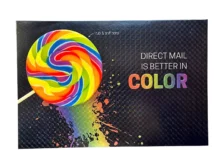
edited by Erin La Row, editor, PostPress
A company’s success is tied to its employees telling the brand story and effectively showcasing capabilities to potential clients – something the crew at D’Andrea Visual Communications (DVC), in Cypress, California, knows all too well. The company began in 2005 as a lithographic printer. It has since expanded in-house with grand format printing and custom fabrication. Today, the company is a visual communications producer for Fortune 500 brands as well as start-ups.
Cold foil is a DVC hallmark – the company needed a visual way to demonstrate its capabilities to clients. Using previously designed graphics the company had on hand, designer Franz Dreikorn, prepress/pressroom manager at DVC, got to work designing a sample booklet.
“We needed to show what we can do as far as foil and Cast and Cure™,” Dreikorn said. The result: an eye-catching booklet that pops with color and shine – showing potential clients the DVC team knows how to help their businesses get noticed and excite customers. Dreikorn said 100 lb. book-weight stock was used. “We wanted to show the difference between cover stock and book-weight stock,” he added.
The Cast and Cure film was supplied by Breit Technologies and the cold foil was supplied by Univacco Foils Corporation. The machinery used in the production of the booklet included a KBA Rapida 106 press with an Eagle Systems cold foil unit. The six-page booklet took home Best Use of Film Casting (Cast and Cure) from the Foil and Specialty Effects Association’s 2022 Gold Leaf Awards.
“I was pretty happy,” Dreikorn said about the award.
The inside pages of the DVC booklet include an example of cold foil only, showcasing its ability to do both larger solids and reversed-out type. Another page demonstrates reversed-out 4-color litho with a Cast and Cure clear holographic background, and the middle of the booklet includes a beautiful two-page spread of a city skyline with a pass of silver cold foil that then was overprinted with 4-color litho – all inline on the KBA press and Eagle cold foil unit. The last two pages showcase a color chart of CMYK colors available for printing or overprinting with silver foil.

Cast and Cure is a decorative process that uses UV/EB varnishes and specialty films to create diffractive surfaces that produce unique finishes for the printing and packaging industries. It forms a consistent high-quality surface that can incorporate ultra-high gloss, matte and holographic finishes on a variety of substrates.
“It gives you a better sheen,” Dreikorn said. “It’s brighter – more of a mirror effect.”
Tim Cain, president of Breit Technologies, Overland Park, Kansas, said, “D’Andrea understands that the Cast and Cure process is more of an overall effect and not just a highlight. Many people use foil as an accent. Due to the reusability of the casting film, an overall Cast and Cure effect can be applied to the whole piece for the same cost as a traditional foil highlight.”
Cain added, “One of the undiscussed benefits of the Cast and Cure process is the enhanced gloss level. The casting film works to calendar the coating to a consistent level, enhancing the gloss level and offering an additional boost with the holographic effect.”
Breit Technologies is credited with introducing Cast and Cure in North America. PostPress previously sat down with Cain to talk about the Cast and Cure process. Cain said it is used in everything from liquor and beverage labels, printed collateral and direct mail to magazine and book covers, and even food and pharmaceutical cartons.
“Brand owners find the clear holographic patterns are an excellent way to grab the consumer’s attention when they’re applied to a carton or label,” Cain said.
The process has many benefits. Since the Cast and Cure film works as a type of mold for the cured UV coating (the film is not actually applied to the substrate), it can be used up to a dozen times – sometimes more – and volatile organic compounds (VOCs) are eliminated with the use of UV/EB varnishes. Less money is spent on shipping fees and warehousing compared to other decorating methods, and the casting films are recyclable.
When asked about clients’ reactions to the booklets, Dreikorn said, “Everybody loves them!”



